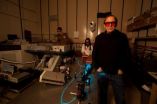(Press-News.org) The finding offers a powerful take on the connection between the brain and behavior, specifically in the context of situations that would normally evoke fear, the researchers say.
"The nature of fear is survival and the amygdala helps us stay alive by avoiding situations, people, or objects that put our life in danger," said Justin Feinstein of the University of Iowa. "Because SM is missing her amygdala, she is also missing the ability to detect and avoid danger in the world. It is quite remarkable that she is still alive."
Feinstein says that the average person may have different definitions of fear, but his goal ultimately is to define emotions including fear based on the biological machinery that triggers them.
"Normally, the amygdala is constantly sorting through all the information coming into our brain through the different senses in order to rapidly detect anything that might impact our survival," he explained. "Once it detects danger, the amygdala orchestrates a rapid full-body response that compels us to stay away from the threat, thereby improving our chances for survival."
To explore this role of the amygdala, Feinstein and his Univeristy of Iowa team observed and recorded SM's responses in a variety of situations that would make most people feel fear. They exposed her to snakes and spiders, took her to one of the world's scariest haunted houses, and had her watch a series of horror films. They also had her fill out questionnaires probing different aspects of fear, from the fear of death to the fear of public speaking. On top of that, SM faithfully recorded her emotions at various times throughout the day while carrying around an electronic diary over a 3-month period. Across all questionnaires, measures, and scenarios, SM failed to experience fear.
That apparent lack of fear mirrored her personal experience, Feinstein said. "In everyday life, SM has encountered numerous traumatic events which have threatened her very existence, and by her report, have caused no fear. Yet, she is able to feel other emotions such as happiness and sadness. Taken together, these findings suggest that the human amygdala is a pivotal area of the brain for triggering a state of fear."
Feinstein said he was most surprised at what happened when SM was presented with snakes and spiders in an exotic pet store. "For many years, SM has been telling us that she 'hates' snakes and spiders and 'tries to avoid them.' Going into the experiment, everyone, including myself, thought SM would stay away from these animals. Yet, to our surprise, she immediately started touching them! When asked why she was touching something that she claims to hate, she appeared perplexed by her own behavior and stated that she was overcome with curiosity. It was as if the part of the brain responsible for SM's cognition and thoughts was completely disconnected from the part of the brain controlling her behavior."
Feinstein says the new findings suggest that methods designed to safely and non-invasively turn off the amygdala might hold promise for those suffering from post-traumatic stress disorder (PTSD).
"This past year, I've been treating veterans returning home from Iraq and Afghanistan who suffer from PTSD," he said. "Their lives are marred by fear, and they are oftentimes unable to even leave their home due to the ever-present feeling of danger. In striking contrast, SM is immune to these states of fear and shows no symptoms of post-traumatic stress. In essence, traumatic events leave no emotional imprint on SM's brain. By understanding how the brain processes fear through cases like SM, we may one day be able to create treatments that selectively target the brain areas that allow fear to take over our lives."
###
For images related to this news and for more research news from Current Biology go to http://www.eurekalert.org/jrnls/cell/pages/currentbiology.php
When the brain knows no fear
2010-12-17
ELSE PRESS RELEASES FROM THIS DATE:
Don't trouble your heart: Naturally high hemoglobin OK in dialysis patients
2010-12-17
Naturally occurring high hemoglobin levels are safe for kidney disease patients on dialysis, according to a study appearing in an upcoming issue of the Journal of the American Society Nephrology (JASN). The results suggest that there is no need to lower these levels to protect patients' health.
The vast majority of individuals who develop advanced chronic kidney disease (CKD) also develop progressive anemia, or red blood cell deficiency, that must be treated with medication. Prior to the approval of such erythropoiesis-stimulating agents in 1989, many dialysis patients ...
New test can predict complications from kidney disease
2010-12-17
Cystatin C, a blood marker of kidney function, proved significantly more accurate than the standard blood marker, creatinine, in predicting serious complications of kidney disease, in a study by researchers at the San Francisco VA Medical Center and the University of California, San Francisco.
Among adults who were identified as having chronic kidney disease by high creatinine levels, the researchers found that only patients who also had abnormally high levels of cystatin C were at high risk for death, cardiovascular disease, heart failure, or kidney failure. People with ...
Immune cell plays unexpected role in autoimmune disease
2010-12-17
A new study provides fascinating insight into the underlying pathology associated with the autoimmune disease, systemic lupus erythematosus (SLE). The research, published by Cell Press in the December issue of the journal Immunity, reveals an unexpected role for a key type of immune cell and provides a potential new therapeutic strategy for SLE and, potentially, other autoimmune diseases.
SLE is a chronic systemic disease that can affect many regions of the body and, as a result, presents with diverse clinical symptoms. As is characteristic of other autoimmune disease, ...
Science's breakthrough of the year: The first quantum machine
2010-12-17
Until this year, all human-made objects have moved according to the laws of classical mechanics. Back in March, however, a group of researchers designed a gadget that moves in ways that can only be described by quantum mechanics—the set of rules that governs the behavior of tiny things like molecules, atoms, and subatomic particles. In recognition of the conceptual ground their experiment breaks, the ingenuity behind it and its many potential applications, Science has called this discovery the most significant scientific advance of 2010.
Physicists Andrew Cleland and ...
Computer memory takes a spin
2010-12-17
SALT LAKE CITY, Dec. 16, 2010 – University of Utah physicists stored information for 112 seconds in what may become the world's tiniest computer memory: magnetic "spins" in the centers or nuclei of atoms. Then the physicists retrieved and read the data electronically – a big step toward using the new kind of memory for both faster conventional and superfast "quantum" computers.
"The length of spin memory we observed is more than adequate to create memories for computers," says Christoph Boehme (pronounced Boo-meh), an associate professor ...
Why humans are more sensitive to certain viruses: Primate immune system differences identified
2010-12-17
The greater susceptibility of humans to certain infectious diseases when compared to other primates could be explained by species-specific changes in immune signaling pathways, a University of Chicago study finds. The first genome-wide, functional comparison of genes regulated by the innate immune system in three primate species discovers potential mediators of differences in disease susceptibility among primates. These findings are published on December 16 in the open-access journal PLoS Genetics.
Humans are more sensitive than chimpanzees to the severe effects of certain ...
Structural distortions emerge from nothing at the nanoscale
2010-12-17
December 16, 2010 - Scientists have discovered that a class of materials known to convert heat to electricity and vice versa behaves quite unexpectedly at the nanoscale in response to changes in temperature. The discovery - described in the December 17, 2010, issue of Science - is a new "opposite-direction" phase transition that helps explain the strong thermoelectric response of these materials. It may also help scientists identify other useful thermoelectrics, and could further their application in capturing energy lost as heat, for example, in automotive and factory ...
Using digitized books as 'cultural genome,' researchers unveil quantitative approach to humanities
2010-12-17
CAMBRIDGE, Mass. -- Researchers have created a powerful new approach to scholarship, using approximately 4 percent of all books ever published as a digital "fossil record" of human culture. By tracking the frequency with which words appear in books over time, scholars can now precisely quantify a wide variety of cultural and historical trends.
The four-year effort, led by Harvard University's Jean-Baptiste Michel and Erez Lieberman Aiden, is described this week in the journal Science.
The team, comprising researchers from Harvard, Google, Encyclopaedia Britannica, ...
Age doesn't matter: New genes are as essential as ancient ones
2010-12-17
New genes that have evolved in species as little as one million years ago – a virtual blink in evolutionary history – can be just as essential for life as ancient genes, startling new research has discovered.
Evolutionary biologists have long proposed that the genes most important to life are ancient and conserved, handed down from species to species as the "bread and butter" of biology. New genes that arise as species split off from their ancestors were thought to serve less critical roles – the "vinegar" that adds flavor to the core genes.
But when nearly 200 new ...
Light dawns on dark gamma-ray bursts
2010-12-17
Gamma-ray bursts (GRBs), fleeting events that last from less than a second to several minutes, are detected by orbiting observatories that can pick up their high energy radiation. Thirteen years ago, however, astronomers discovered a longer-lasting stream of less energetic radiation coming from these violent outbursts, which can last for weeks or even years after the initial explosion. Astronomers call this the burst's afterglow.
While all gamma-ray bursts [1] have afterglows that give off X-rays, only about half of them were found to give off visible light, with the ...

